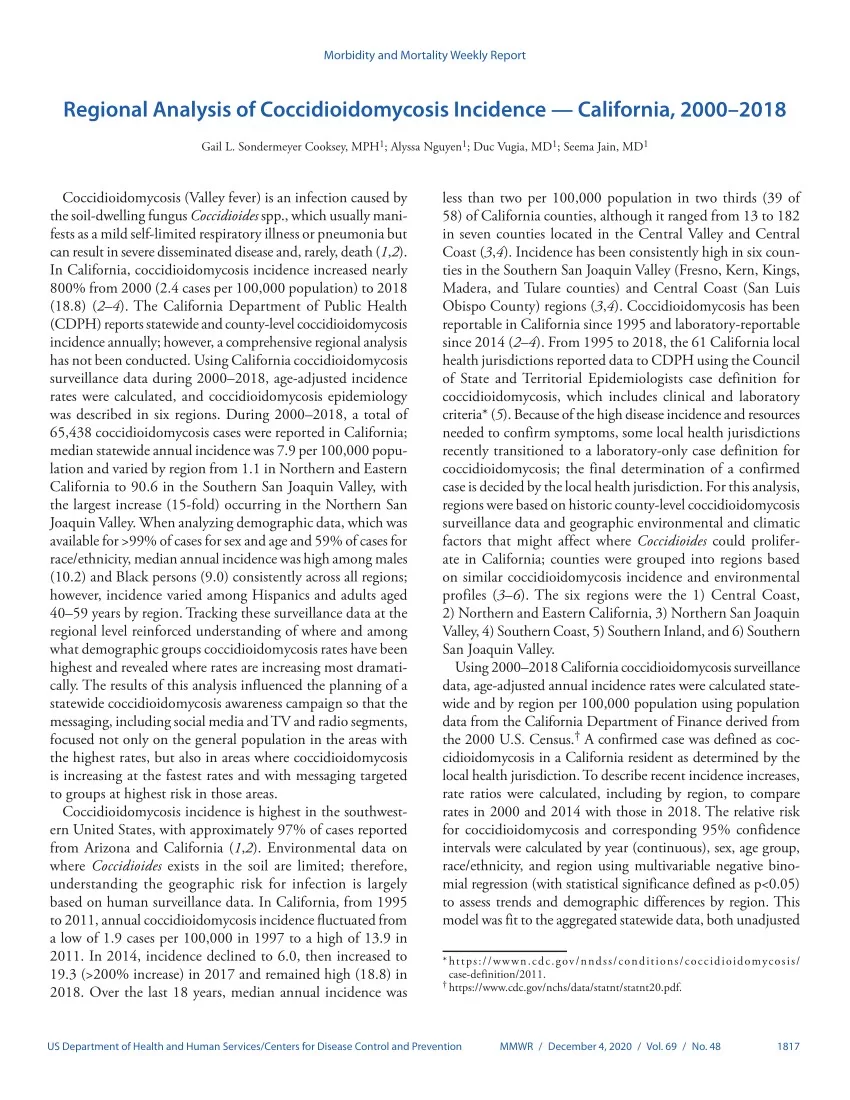Coccidioidomycosis incidence California has become a significant public health concern in recent years, particularly due to its alarming rise linked to changing climate conditions. With nearly 10,000 cases reported in 2023 alone, this fungal infection caused by *Coccidioides spp.* is thriving in environments affected by California’s extreme weather patterns. The relationship between drought and fungal growth is particularly troubling, as the dry conditions clear away soil competitors, allowing *Coccidioides* to flourish once the rains return. As climate change continues to influence weather systems across the state, forecasts suggest an alarming increase in cases, potentially reaching over 12,000 by 2025. Understanding these trends is crucial for healthcare providers and public health officials to prepare effective responses to this emerging fungal threat in California.
The rising prevalence of coccidioidomycosis, commonly referred to as valley fever, is emerging as a pressing issue within California’s public health landscape. This infectious disease, attributed to the *Coccidioides* fungus, has shown a marked increase, particularly as climatic variations exacerbate its spread. Localized weather extremes, characterized by alternating drought and heavy rainfall, create optimal conditions for the fungus to grow and disperse. As the state grapples with these climatic fluctuations, it becomes vital to examine the implications for fungal infections and develop comprehensive disease management strategies. By focusing on the evolving patterns of Coccidioides disease, individuals and communities can better navigate the risks associated with this endemic fungal infection.
Understanding Coccidioidomycosis in California
Coccidioidomycosis, commonly known as Valley Fever, is a fungal infection caused by *Coccidioides spp.* that thrives in arid climates, such as those found in California. The disease often occurs in individuals who inhale the spores of the fungus, which can be easily dispersed by wind. Due to California’s unique climate conditions, particularly the extreme drought and subsequent heavy rainfall cycles, the incidence of coccidioidomycosis has significantly increased over recent years, leading to public health concerns. With around 9,054 reported cases in 2023, the trend appears to be worsening as more individuals are exposed to the pathogen during periods of arid weather followed by wet seasons.
The connection between California’s changing climate and rising rates of coccidioidomycosis illustrates the critical impact of environmental factors on fungal infections. As California moves toward wetter winters and hotter summers, the conditions for *Coccidioides* fungi are becoming more favorable, leading to increased spore viability and subsequent infections. Understanding the transmission dynamics and factors leading to the increase in *Coccidioidomycosis* within the state is essential for developing effective preventive strategies and public health responses.
Frequently Asked Questions
What is the current incidence of coccidioidomycosis in California?
As of 2023, California reported a near-record number of 9,054 coccidioidomycosis cases, which is a significant increase over previous years. The incidence is expected to continue rising, with forecasts predicting 12,244 cases from April 1, 2024, to March 31, 2025, indicating a 62% increase compared to two years prior.
How does climate change affect the incidence of coccidioidomycosis in California?
Climate change significantly influences the incidence of coccidioidomycosis in California by altering hydroclimatic patterns. The transition from extreme drought to heavy rainfall, as experienced in late 2022 and early 2023, creates conditions that promote fungal growth and increase the availability of *Coccidioides* spores, leading to higher infection rates.
What role do drought conditions play in the spread of fungal infections in California?
Drought conditions can enhance the spread of fungal infections such as coccidioidomycosis in California. During droughts, reduced microbial competition in the soil may promote *Coccidioides* growth, and subsequent wet seasons can lead to increased spore dispersal during hot, dry periods, raising the risk of infection.
What is the forecast for coccidioidomycosis cases in California for the next few years?
The forecast for coccidioidomycosis cases in California indicates ongoing high incidence rates, with 12,244 cases projected for the period from April 1, 2024, to March 31, 2025. This trend highlights the potential for an ongoing spike in infections due to the impacts of climate variability.
How does precipitation influence coccidioidomycosis incidence in California?
Precipitation plays a crucial role in coccidioidomycosis incidence in California. Wet winters contribute to increased soil moisture, which supports fungal growth and leads to a surplus of spores ready for dispersal in the drier summer months, thus raising the risk of fungal infections.
What seasonal patterns are observed in coccidioidomycosis cases in California?
Coccidioidomycosis cases in California typically show seasonal patterns, with incidence rising in June, peaking in November, and then declining. The peak case counts are linked to the dry and dusty conditions that enhance spore dispersal, highlighting the importance of understanding seasonal variations for effective public health strategies.
What preventive measures can individuals take to reduce the risk of coccidioidomycosis in California?
To reduce the risk of coccidioidomycosis, individuals should avoid disturbing dust in endemic areas, practice dust suppression techniques, and consider wearing N95 masks when engaging in activities that may release spores into the air, especially during dry months.
Why is it important to forecast coccidioidomycosis incidence in California?
Forecasting coccidioidomycosis incidence is vital for public health as it provides insights into when and where the risk of infection might be highest. This information aids healthcare providers in early diagnosis, improves management strategies, and raises public awareness about potential exposure risks.
What regions in California are expected to see the highest coccidioidomycosis cases?
The model forecasts indicate that the Southern San Joaquin Valley, Southern Coast, and Central Coast regions of California will experience the highest numbers of coccidioidomycosis cases, with significant concentrations of infections expected in these areas.
How can public health officials use coccidioidomycosis forecasts?
Public health officials can use coccidioidomycosis forecasts to develop targeted communication and intervention strategies, enabling them to inform communities about potential risks, educate the public on prevention measures, and allocate healthcare resources effectively in anticipation of potential outbreaks.
| Year | Reported Cases | Forecasted Cases | Increase (%) | Peak Month | Key Factors |
|---|---|---|---|---|---|
| 2021 | 6,000 | N/A | N/A | N/A | N/A |
| 2022 | 6,800 (est.) | N/A | N/A | N/A | N/A |
| 2023 | 9,054 | 10,519 (2023-2024) | 39% | November | Transition from drought to heavy precipitation, warm summer conditions. |
| 2024 (Forecast) | N/A | 12,244 | 62% from 2022 | November | Continued wet conditions, potential dust exposure during dry months. |
Summary
Coccidioidomycosis incidence in California is projected to increase significantly, with forecasts suggesting a 62% rise in cases from recent years. The correlation between hydroclimatic changes, such as the transition from drought to heavy precipitation, and the emergence of coccidioidomycosis has become more evident. As fungal growth thrives in moist conditions, the prevalence of this infectious disease is expected to continue, particularly during the summer and fall when increased dust allows the spread of *Coccidioides* spores. Public health initiatives are crucial to raise awareness about this rising risk, especially in endemic regions.
The content provided on this blog (e.g., symptom descriptions, health tips, or general advice) is for informational purposes only and is not a substitute for professional medical advice, diagnosis, or treatment. Always seek the guidance of your physician or other qualified healthcare provider with any questions you may have regarding a medical condition. Never disregard professional medical advice or delay seeking it because of something you have read on this website. If you believe you may have a medical emergency, call your doctor or emergency services immediately. Reliance on any information provided by this blog is solely at your own risk.








